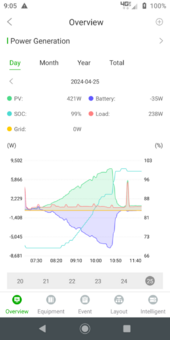RCinFLA
Solar Wizard
- Joined
- Jun 21, 2020
- Messages
- 3,565
When in doubt, check cell voltages with no cell current for at least five minutes to give cells a chance to reach equilibrium on no-load voltage.
If your no-load rested cell voltages are greater than 3.45vdc on each cell the battery is fully charged, and likely Columb counter is off.
3.45v x 16 cells is 55.2vdc, but total battery voltage does tell you if cells are out balance, so some cells are still below 3.45v while higher SoC cell voltages are making up the total battery voltage being over 55.2vdc. Battery monitors and inverters can only make judgement of 100% state of charge by total battery voltage, unless they are getting other info from BMS communications that tells it a different story.
BMS's can have various ways to declare full charge (like common method of forcing a cell overvoltage charging shutdown). It may only be based on total battery voltage or individual cell voltage achieving a minimum voltage. The later criterion is rare as it can run into conflicts when there is out of balance conditions that cause a cell overvoltage charge shutdown before lowest state of charge battery reaches minimum required voltage for 100% charge declaration.
Even allowing a BMS single cell overvoltage charge shutdown does not mean the lowest cell rested voltage is above 3.45v assuring the pack is fully charged.
If you do not let the Columb counters in BMS, battery monitor, or inverter's Columb counter to periodically reset to full state by fully charging, then 100% full is just based on Columb counter record keeping of positive and negative current flow over time. Without a full reference reset every few months the Columb counter error just continues to grow over time.
The best sure way for a Columb counter reset by a full state of charge is with BMS checking every cell voltage and reset Columb counter to 100% when charging current tapers off to very low level and all cells are above 3.50v. Allowing charging current to taper down to low levels minimizes cell overpotential voltage bump up due to charging current and the 3.50v minimum cell voltage allows for a little bit of charging overpotential bump up voltage margin at low charging current. If cells are out of balance you will unlikely be able to meet this criterion before the highest SoC cell trips a BMS overvoltage charge shutdown at which point the Columb counter will not be reset to 100%.
If your no-load rested cell voltages are greater than 3.45vdc on each cell the battery is fully charged, and likely Columb counter is off.
3.45v x 16 cells is 55.2vdc, but total battery voltage does tell you if cells are out balance, so some cells are still below 3.45v while higher SoC cell voltages are making up the total battery voltage being over 55.2vdc. Battery monitors and inverters can only make judgement of 100% state of charge by total battery voltage, unless they are getting other info from BMS communications that tells it a different story.
BMS's can have various ways to declare full charge (like common method of forcing a cell overvoltage charging shutdown). It may only be based on total battery voltage or individual cell voltage achieving a minimum voltage. The later criterion is rare as it can run into conflicts when there is out of balance conditions that cause a cell overvoltage charge shutdown before lowest state of charge battery reaches minimum required voltage for 100% charge declaration.
Even allowing a BMS single cell overvoltage charge shutdown does not mean the lowest cell rested voltage is above 3.45v assuring the pack is fully charged.
If you do not let the Columb counters in BMS, battery monitor, or inverter's Columb counter to periodically reset to full state by fully charging, then 100% full is just based on Columb counter record keeping of positive and negative current flow over time. Without a full reference reset every few months the Columb counter error just continues to grow over time.
The best sure way for a Columb counter reset by a full state of charge is with BMS checking every cell voltage and reset Columb counter to 100% when charging current tapers off to very low level and all cells are above 3.50v. Allowing charging current to taper down to low levels minimizes cell overpotential voltage bump up due to charging current and the 3.50v minimum cell voltage allows for a little bit of charging overpotential bump up voltage margin at low charging current. If cells are out of balance you will unlikely be able to meet this criterion before the highest SoC cell trips a BMS overvoltage charge shutdown at which point the Columb counter will not be reset to 100%.




